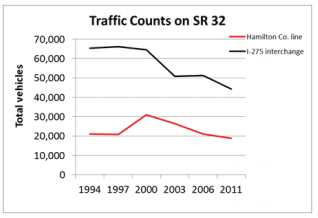Decades ago, Ohio officials drew a line on a map -- the Eastern Corridor, a highway for commuters living in Cincinnati's eastern suburbs. No matter how much time has passed and how little sense it makes to build that highway today, that line can still seem like destiny.

The Eastern Corridor began as a 1960s vision for a highway connecting bedroom communities in mostly rural Clermont County to downtown Cincinnati, roughly 17 miles away. There is not much appetite for it: As soon as Ohio DOT dusted off its plans and started laying the groundwork to build this $1.4 billion project in 2011, communities along the corridor revolted.
The project lives on anyway. Last week, it seemed like state legislators were poised to reject the highway, but the thought of turning down a big construction project -- no matter how wasteful and unwanted -- was too much for some lawmakers to bear. The Eastern Corridor remains a looming possibility, a case study in how highway projects can develop a nearly unstoppable political momentum.
The outcry against the Easter Corridor has been growing since the moment ODOT told the public what it wanted to build. Along almost every section of the planned road, residents, neighborhoods, and whole towns tried to stop the project.
The most fiercely opposed sections involve rerouting State Route 32 through Newtown and Mariemont -- two small, relatively affluent inner-ring suburbs. The road would cut through the heart of tiny Newtown, where the leadership is adamantly opposed, saying it will destroy the town's business center. In Mariemont, it would ruin a park referred to as the South 80.
The Eastern Corridor also calls for a poorly-conceived rail line, expected to cost as much as $600 million and draw as few as 3,000 daily riders. The region's rail advocates oppose it, calling it a waste of money.
Even farther away suburbs are not exactly thrilled about the highway. Andersen Township Trustee Russell Jackson told the Cincinnati Enquirer that “nobody in the local communities really sees this incredible benefit to building this thing."
There are pockets of support for the project, including rural Clermont County, but overall, public opinion against the Eastern Corridor appears to be strong enough to sink it. Jason Williams at the Enquirer wondered last week if it was "on life support."
Republican State Representative Tom Brinkman, elected by an eastern district of Cincinnati that will be affected by the road, attempted to put the whole thing to rest with legislation that would ban state money from going toward the Eastern Corridor. It was both a principled and rational political stance. After all, Brinkman prides himself on his fiscal conservatism, and the people who voted for him hate the project. "I am representing constituents who say, ‘We don’t want to tear down our communities,'" he told the Enquirer.

But the Eastern Corridor still has one thing going for it that all highway projects do: the promise of a lot of spending. Democratic State Representative Denise Driehaus, who represents a different part of Cincinnati, said at a finance committee meeting last week that she hated the idea of southwest Ohio "losing" money.
The fear of missing out on highway money prevailed, and the project staggers on. The southwest Ohio delegation agreed to give the state of Ohio until March 31 to decide whether to continue the project -- and if ODOT decides to kill it, the money will be reserved for that part of the state.
The episode is a testament to the power wielded by ODOT: the power of the purse. Not only does ODOT have the final say over whether the highway gets built, but elected officials aren't even willing to challenge the agency if it means "losing money" for their area.
Making matters worse is that ODOT is effectively broke. Ohio hasn't raised its gas tax in 10 years and has no money to spare on transportation, yet state officials always manage to spend huge sums on highway projects.
In order to plug Ohio DOT's budget gap, Governor John Kasich sold state lawmakers on bonding $1.5 billion against future turnpike revenues [PDF]. At the express demand of northern Ohio lawmakers, all of that money was reserved for their part of the state. And because ODOT still sees itself first and foremost as a highway builder, all of it will be pumped into new highway capacity, even though northern Ohio is losing population.
In the next two years, gas tax revenues are expected to come up $1 billion short against the state's road construction plans, according to the Columbus Dispatch.
Meanwhile, Ohio continues to scandalously shortchange transit, with the state committing just $8.3 million per year, or less than a dollar per resident per year. The additional $1 million the state recently added to its transit budget amounts to 1/1,400 the cost of the Eastern Corridor.





